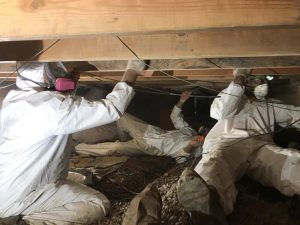Tackling Mold After a Flood: 911 Restoration’s Complete Emergency Solutions
The combination of flooding and the subsequent risk of mold growth presents a dual threat that homeowners must address urgently. This article will provide an in-depth look at the connection between flooding and mold, why professional help is crucial, and how 911 Restoration’s services can offer a comprehensive solution.
The Connection Between Flooding and Mold
Floodwaters introduce excess moisture into the home, creating an ideal environment for mold growth. Without proper intervention, mold can develop within 24 to 48 hours of a flood event, making immediate action essential.
Immediate Actions to Take After a Flood
In the aftermath of a flood, prioritize safety by turning off electrical utilities and avoiding floodwaters that may be contaminated. Initial cleanup steps should include removing as much water as possible and beginning the drying process to minimize mold risk.
Why Professional Help is Crucial
While DIY methods can offer temporary relief, they often fall short in fully mitigating the risk of mold. Professional services bring expertise and specialized equipment for a comprehensive solution, ensuring that both visible and hidden mold is effectively dealt with.
911 Restoration’s Mold Remediation Services
Our services include:
- Inspection and assessment
- Mold removal and cleaning
- Air purification and dehumidification We also offer repairs to affected surfaces and structures, including drywall, flooring, and ceilings.
Additional Services from 911 Restoration
Besides mold remediation, we offer:
- Emergency flood water removal
- Sewage cleanup
- Fire and smoke damage restoration We are available 24/7 for all emergencies.
Health Risks of Mold
Untreated mold can pose serious health risks, including respiratory issues, allergic reactions, and in severe cases, neurological problems. Addressing mold promptly is essential for maintaining a healthy living environment.
Insurance and Cost Concerns
Review your insurance policy carefully for coverage details regarding flood and mold damage. 911 Restoration can assist in navigating the complex insurance claims process.
How 911 Restoration Stands Out
We pride ourselves on a 45-minute ETA for emergencies, ensuring prompt action to minimize damage. Our team comprises IICRC-certified professionals committed to our “Fresh Start” philosophy, which aims to turn every disaster into an opportunity for renewal.
Frequently Asked Questions
We’ve compiled a list of FAQs to address common concerns about flood and mold remediation, which can be accessed on our website or through a consultation call.
How do you mitigate mold after a flood?
Mitigating mold after a flood involves a multi-step process that starts with immediate water removal and drying of the affected area. This is followed by thorough cleaning and sanitization to kill existing mold spores. Dehumidifiers and air purifiers may be used to control moisture and improve air quality.
What is the most common mold from water damage?
The most common types of mold resulting from water damage include Aspergillus, Penicillium, and Cladosporium. These molds can cause a variety of health issues, including respiratory problems and allergic reactions.
How quickly does mold grow after a flood?
Mold can begin to grow as quickly as 24 to 48 hours after a flood if the conditions are conducive, which includes warm temperatures and high humidity. This makes rapid intervention critical in preventing mold proliferation.
Where does mold grow after a flood?
Mold typically grows in areas where excess moisture is present. After a flood, this can include walls, floors, carpets, furniture, and even behind appliances. Hidden areas such as crawl spaces, attics, and inside walls are also common places where mold may develop.
What kills mold from water damage?
Mold from water damage can be effectively killed using a variety of solutions including commercial mold removers, bleach, hydrogen peroxide, or vinegar. It’s essential to also address the root cause — excess moisture — by using dehumidifiers and ensuring good ventilation.
What is the difference between mold mitigation and remediation?
Mold mitigation refers to steps taken to limit the extent of mold growth by addressing the underlying moisture problem and cleaning up minor mold issues. Mold remediation is a more comprehensive approach that involves removing all mold growth, sanitizing the area, and taking steps to prevent future mold problems. Remediation aims to completely resolve the mold issue, whereas mitigation aims to manage and contain it.
Quality Restoration Services and Great Communication is Our Priority
Act fast to prevent mold after a flood. Contact our IICRC-certified team at 911 Restoration of Salt Lake City for a free inspection and take the first step toward a “Fresh Start.” Addressing both flood and mold issues promptly is critical for your home’s structural integrity and your family’s health.
911 Restoration of Salt Lake City is your go-to solution for emergency mold and flood remediation. We understand the importance of swift, effective action and clear communication in these stressful situations. Trust us to turn your crisis into a new beginning.



